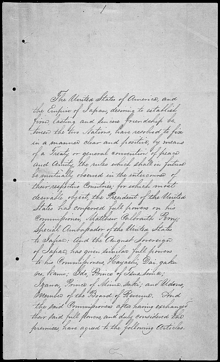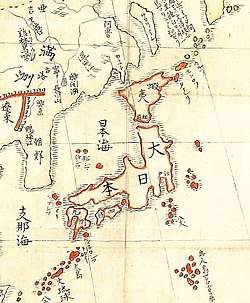Convention of Kanagawa
On March 31, 1854, the Convention of Kanagawa (Japanese: 日米和親条約, Hepburn: Nichibei Washin Jōyaku, "Japan and US Treaty of Peace and Amity") or Kanagawa Treaty (神奈川条約, Kanagawa Jōyaku) became the first treaty between the United States and the Tokugawa shogunate.
Long name:
| |
|---|---|
 Japanese copy of the Convention of Kanagawa, ratified February 21, 1855 | |
| Signed | 31 March 1854 |
| Location | Yokohama, Japan |
| Sealed | March 31, 1854 |
| Effective | September 30, 1855 |
| Condition | Ratification by US Congress and signing by Emperor Kōmei of Japan |
| Signatories | |
| Depositary | Diplomatic Record Office of the Ministry of Foreign Affairs (Japan) |
| Languages |
|
Signed under threat of force, it effectively meant the end of Japan's 220-year-old policy of national seclusion (sakoku) by opening the ports of Shimoda and Hakodate to American vessels.[1] It also ensured the safety of American castaways and established the position of an American consul in Japan. The treaty also precipitated the signing of similar treaties establishing diplomatic relations with other Western powers.
Isolation of Japan
Since the beginning of the seventeenth century, the Tokugawa shogunate pursued a policy of isolating the country from outside influences. Foreign trade was maintained only with the Dutch and the Chinese and was conducted exclusively at Nagasaki under a strict government monopoly. This policy had two main objectives. One was the fear that trade with western powers and the spread of Christianity would serve as a pretext for the invasion of Japan by imperialist forces, as had been the case with most of the nations of Asia. The second objective was fear that foreign trade and the wealth developed would lead to the rise of a daimyō powerful enough to overthrow the ruling Tokugawa clan.[2]
By the early nineteenth century, this policy of isolation was increasingly under challenge. In 1844, King William II of the Netherlands sent a letter urging Japan to end the isolation policy on its own before change would be forced from the outside. In 1846, an official American expedition led by Commodore James Biddle arrived in Japan asking for ports to be opened for trade, but was sent away.[3]
Perry expedition
In 1853, United States Navy Commodore Matthew C. Perry was sent with a fleet of warships by US president Millard Fillmore to force the opening of Japanese ports to American trade, through the use of gunboat diplomacy if necessary.[4] The growing commerce between America and China, the presence of American whalers in waters offshore Japan, and the increasing monopolization of potential coaling stations by the British and French in Asia were all contributing factors. The Americans were also driven by concepts of Manifest Destiny and the desire to impose the benefits of western civilization on what they perceived as backward Asian nations. For the Japanese standpoint, increasing contacts with foreign warships and the increasing disparity between western military technology and the Japanese feudal armies created growing concern. The Japanese had been keeping abreast of world events via information gathered from Dutch traders in Dejima and had been forewarned by the Dutch of Perry's voyage.[5] There was considerable internal debate in Japan on how best to meet this potential threat to Japan's economic and political sovereignty in light of events occurring in China with the Opium Wars.
Perry arrived with four warships at Uraga, at the mouth of Edo Bay on July 8, 1853. After refusing Japanese demands that he proceed to Nagasaki, which was the designated port for foreign contact, and after threatening to continue directly on to Edo, the nation's capital, and to burn it to the ground if necessary, he was allowed to land at nearby Kurihama on July 14 and to deliver his letter.[6]
Despite years of debate on the isolation policy, Perry's letter created great controversy within the highest levels of the Tokugawa shogunate. The shōgun himself, Tokugawa Ieyoshi, died days after Perry's departure, and was succeeded by his sickly young son, Tokugawa Iesada, leaving effective administration in the hands of the Council of Elders (rōjū) led by Abe Masahiro. Abe felt that it was currently impossible for Japan to resist the American demands by military force, and yet was reluctant to take any action on his own authority for such an unprecedented situation. Attempting to legitimize any decision taken, Abe polled all of the daimyō for their opinions. This was the first time that the Tokugawa shogunate had allowed its decision-making to be a matter of public debate, and had the unforeseen consequence of portraying the shogunate as weak and indecisive.[7] The results of the poll also failed to provide Abe with an answer as, of the 61 known responses, 19 were in favor of accepting the American demands and 19 were equally opposed. Of the remainder, 14 gave vague responses expressing concern of possible war, 7 suggested making temporary concessions and two advised that they would simply go along with whatever was decided.[8]
Perry returned again on February 13, 1854, with an even larger force of eight warships and made it clear that he would not be leaving until a treaty was signed. Negotiations began on March 8 and proceeded for around one month. The Japanese side gave in to almost all of Perry's demands, with the exception of a commercial agreement modeled after previous American treaties with China, which Perry agreed to defer to a later time. The main controversy centered on the selection of the ports to open, with Perry adamantly rejecting Nagasaki. The treaty, written in English, Dutch, Chinese and Japanese, was signed on March 31, 1854 at what is now known as Kaikō Hiroba (Port Opening Square) Yokohama, a site adjacent to the current Yokohama Archives of History.[8]
Treaty of Peace and Amity (1854)

The "Japan–US Treaty of Peace and Amity" has twelve articles:
| Article | Summary |
|---|---|
| § I | Mutual peace between the United States and the Empire of Japan |
| § II | Opening of the ports of Shimoda & Hakodate |
| § III | Assistance to be provided to shipwrecked American sailors |
| § IV | Shipwrecked sailors not to be imprisoned or mistreated |
| § V | Freedom of movement for temporary foreign residents in treaty ports (with limitations)[9] |
| § VI | Trade transactions to be permitted |
| § VII | Currency exchange to facilitate any trade transactions to be allowed |
| § VIII | Provisioning of American ships to be a Japanese government monopoly |
| § IX | Japan to also give the United States any favorable advantages which might be negotiated by Japan with any other foreign government in the future |
| § X | Forbids the United States from using any other ports aside from Shimoda and Hakodate |
| § XI | Opening of an American consulate at Shimoda |
| § XII | Treaty to be ratified within 18 months of signing |
The final article, Article Twelve, stipulated that the terms of the treaty were to be ratified by the President of the United States and the "August Sovereign of Japan" within 18 months. At the time, shōgun Tokugawa Iesada was the de facto ruler of Japan; for the Emperor to interact in any way with foreigners was out of the question. Perry concluded the treaty with representatives of the shogun, led by plenipotentiary Hayashi Akira (林韑) and the text was endorsed subsequently, albeit reluctantly, by Emperor Kōmei.[10] The treaty was ratified on February 21, 1855.[11]
Consequences of the treaty
| History of Japan |
|---|
 |
In the short term, the US was content with the agreement since Perry had achieved his primary objective of breaking Japan's sakoku policy and setting the grounds for protection of American citizens and an eventual commercial agreement. On the other hand, the Japanese were forced into this trade, and many saw it as a sign of weakness. The Tokugawa shogunate could point out that the treaty was not actually signed by the Shogun, or indeed any of his rōjū, and that it had at least temporarily averted the possibility of immediate military confrontation.[12]
Externally, the treaty led to the United States-Japan Treaty of Amity and Commerce, the "Harris Treaty" of 1858, which allowed the establishment of foreign concessions, extraterritoriality for foreigners, and minimal import taxes for foreign goods. The Japanese chafed under the "unequal treaty system" which characterized Asian and western relations during this period.[13] The Kanagawa treaty was also followed by similar agreements with the United Kingdom (Anglo-Japanese Friendship Treaty, October 1854), the Russians (Treaty of Shimoda, February 7, 1855), and the French (Treaty of Amity and Commerce between France and Japan, October 9, 1858).
Internally, the treaty had far-reaching consequences. Decisions to suspend previous restrictions on military activities led to re-armament by many domains and further weakened the position of the Shogun.[14] Debate over foreign policy and popular outrage over perceived appeasement to the foreign powers was a catalyst for the sonnō jōi movement and a shift in political power from Edo back to the Imperial Court in Kyoto. The opposition of Emperor Kōmei to the treaties further lent support to the tōbaku (overthrow the Shogunate) movement, and eventually to the Meiji Restoration.
Kanagawa Treaty House
The Convention was negotiated and then signed in a purpose-built house in Yokohama, Japan, the site of which is now the Yokohama Archives of History.
Notes
- Perry, Matthew Calbraith (1856). Narrative of the expedition of an American Squadron to the China Seas and Japan, 1856.
- W. G. Beasley, The Meiji Restoration, pp. 74–77
- W. G. Beasley, The Meiji Restoration, p. 78
- J. W. Hall, Japan, p. 207.
- W. G. Beasley, The Meiji Restoration, p. 88.
- W. G. Beasley, The Meiji Restoration, p. 89.
- J. W. Hall, Japan, p. 211.
- W. G. Beasley, The Meiji Restoration, pp. 90–95.
- "From Washington; The Japanese Treaty-Its Advantages and Disadvantages-The President and Col. Rinney, &c.," New York Times. October 18, 1855.
- Cullen, Louis M. (2003). A History of Japan, 1582–1941: Internal and External Worlds, pp. 173–185.
- Diplomatic Record Office of the Ministry of Foreign Affairs (Japan) exhibit.
- W. G. Beasly, The Meiji Restoration, pp. 96–97
- Bert Edström, Bert. (2000). The Japanese and Europe: Images and Perceptions, pp. 101.
- J. W. Hall, Japan, pp. 211–213.
References
- Arnold, Bruce Makoto (2005). Diplomacy Far Removed: A Reinterpretation of the U.S. Decision to Open Diplomatic Relations with Japan (Thesis). University of Arizona.
- Auslin, Michael R. (2004). Negotiating with Imperialism: The Unequal Treaties and the Culture of Japanese Diplomacy. Cambridge: Harvard University Press. ISBN 978-0-674-01521-0; OCLC 56493769
- Bert Edström, Bert. (2000). The Japanese and Europe: Images and Perceptions. London: Routledge. ISBN 978-1-873410-86-8
- Cullen, L. M. (2003). A History of Japan, 1582–1941: Internal and External Worlds. Cambridge: Cambridge University Press. ISBN 0-521-52918-2 (paper)
- Perry, Matthew Calbraith. (1856). Narrative of the expedition of an American Squadron to the China Seas and Japan, 1856. New York : D. Appleton and Company. [digitized by University of Hong Kong Libraries, Digital Initiatives, "China Through Western Eyes." ]
- Taylor, Bayard. (1855). A visit to India, China, and Japan in the year 1853 New York : G.P. Putnam's sons. digitized by University of Hong Kong Libraries, Digital Initiatives, "China Through Western Eyes".
- Beasley, William G (1972). The Meiji Restoration. Stamford University Press. ISBN 978-0804708159.
- Hall, John Whitney (1991). Japan: From Prehistory to Modern Times. University of Michigan. ISBN 978-0939512546.
External links
| Wikimedia Commons has media related to Convention of Kanagawa. |
| Wikisource has original text related to this article: |